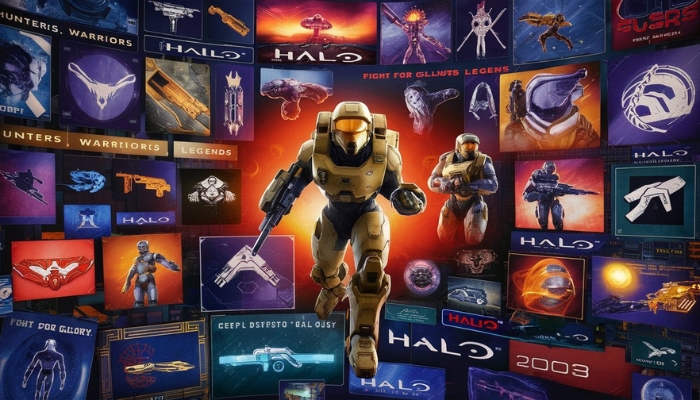After its 2003 release, Halo revolutionised the first-person shooter genre and went on to become an important part of gaming history. Its innovative gameplay, engrossing story, and endearing characters have had a significant impact on the industry. Its numerous success reasons included the in-game banners and symbols, which gave users unique opportunities to personalise their gaming. The significance of the various icon and banner styles found in Halo (2003) is examined in this article.
Player Icons
Player icons in Halo (2003) were succinct yet potent representations of players in lobbies and menus. Often, these symbols featured a special emblem or the Spartan figure that the player had chosen. They were a major feature in multiplayer lobbies and provided a platform for individuals to show off their individuality, which had a big impact on the social interactions in the game.
Rank Icons
In Halo’s multiplayer mode, rank icons were essential for displaying a player’s level of ability and advancement. Players were able to access new, more renowned icons as they advanced. These status symbols encouraged players to improve their abilities and move up the competitive ladder.
Weapon Icons
The heads-up display (HUD) and menus in the game heavily relied on weapon icons. These icons represented the various weapons that players may use, such as the well-known Energy Sword, Sniper Rifle, and Assault Rifle. During hectic battle scenarios, players were able to quickly recognise their present weapons and arrange their armoury thanks to its clarity and uniqueness.
Vehicle Icons
Similar to weapon icons, vehicle icons showed the many kinds of vehicles that players could control. Among the many locales in the game, these emblems allowed players to identify and choose their favourite means of combat and transportation, whether it was the agile Ghost or the powerful Scorpion Tank.
Equipment Icons
The equipment icons displayed the variety of stuff that players may equip themselves with, such as tactical items, health packs, and grenades. These icons were crucial for monitoring the situation and making sure players could get hold of the resources they needed to win the game.
Clan Banners
One special feature that allowed users to display their clan’s customised banner was the ability to display clan banners. Members of the clan developed a sense of camaraderie and community as a result of these banners, which functioned as a sign of identity and pride. They significantly impacted the social interactions in the game and were highly customisable and widely displayed.
The Importance of Banners and Icons
In Halo (2003), banners and icons served more purposes than merely aesthetics. They served useful purposes, like facilitating navigation and enhancing the user interface. Above all, they allowed players to express their uniqueness and loyalty, strengthening the bonds between them and the game’s community.
Customization and Personalization
The ability to customise banners and emblems added a dimension of personalisation that captivated players. Players were able to leave their mark on the game by selecting a unique symbol, rising in rank, or displaying a clan’s banner, among other things. The game’s enduring appeal was greatly influenced by this personalisation.
The Creation of Banners and Icons
The Halo series has developed since its 2003 release, adding new banners and iconography to its later games. However, the core components from the first game have persisted, demonstrating their usefulness and user appeal.
Locating Icons and Banners Today
Since official sources might not be available, it can be challenging to locate the original Halo (2003) icons and banners. However, online forums and fan communities usually include resources like re-created photos or downloaded data. These neighborhood-based projects help to maintain the history of the game while allowing new players to take advantage of its classic features.
reputable sites to download from
It’s important to obtain content from reliable sources when looking for icons and banners online in order to prevent malware or copyright issues. Official forums and reliable fan sites are great places to start. Before downloading, make sure the files are safe and free of dangerous software.
The Role of Fan Communities
The spirit of Halo has been preserved in large part because to fan communities (2003). These dedicated communities ensure that the game’s enduring features are accessible to successive generations of gamers by pooling resources and creating and regenerating content.
The Influence on Contemporary Gaming
The customisation features that were first available in Halo (2003) have greatly influenced many games that are released today. Numerous other games have adopted and changed the concept of player icons, rank emblems, and clan flags, demonstrating Halo’s ongoing influence on the video game industry.
The Nostalgia Factor
The symbols and banners from Halo (2003) evoke nostalgia in a lot of players. They serve as reminders of the innumerable hours devoted to the game, the bonds formed, and the titanic conflicts fought. Even years after the game’s original release, players are still drawn back to it by this sense of nostalgia.
Conclusion
The ground-breaking video game Halo (2003) brought in a number of firsts, such as its distinctive banners and emblems. These components improved the gaming experience and let users personalise their journey through the game. When one considers Halo’s legacy, it becomes clear that these minor but significant elements contributed significantly to the game’s popularity and its allure.
ConclusionFinal Thoughts
In Halo (2003), banners and icons were an integral part of the gameplay and not just decorative elements. They provided a means for users to communicate with one another, express themselves, and keep track of their progress. It’s important to acknowledge these elements’ ongoing influence on the game industry as we honour Halo’s legacy.
